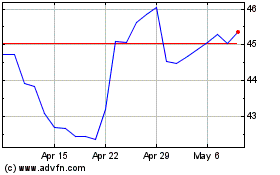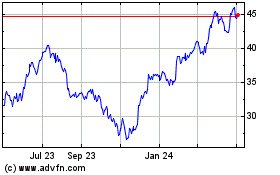By Timothy Puko and Chester Dawson
The leaders of the world's biggest car companies are arriving at
the White House on Friday, and it may be their last chance to stop
the Trump administration from a head-on collision with
California.
The Trump administration wants to dramatically cut back on
Obama-era emissions regulations, which are supported by California
and other states. But while the president and his senior advisers
have signaled willingness to confront the resistance from
California and its allies, they are also frustrated by what they
describe as tepid support from car makers for the administration's
initiative to roll back rules.
The White House, along with its environmental and transportation
regulators, are bringing in chief executives from the big three
U.S. brands -- General Motors Co., Ford Motor Co. and Fiat Chrysler
Automobiles NV -- and representatives from several international
car makers to forge a common stance over fuel-economy
requirements.
Auto makers have complained the standards for their cars and
trucks are too rigorous, saying they don't reflect consumer demand.
But the rollback being proposed by the White House is so extensive,
some are concerned it will cause more problems than it seeks to
solve.
High on the agenda will be California, which has its own powers
over fuel-efficiency standards and is already suing to stop the
administration's overhaul. That has escalated a power struggle
between Washington and Sacramento that some fear will force auto
makers to start meeting two different standards for selling cars
and trucks across the U.S.
Ford Motor's CEO Jim Hackett and chair William Clay Ford Jr.
have signaled their desire for a compromise. "We're not asking the
administration for a roll back," Mr. Ford told shareholders at the
company's annual meeting Thursday. "We want California at the
table, and we want one national standard that includes
California."
Mr. Hackett added at the meeting: "Bill and I have been clear in
our position that Ford is designing its business to exceed and meet
those standards that were set previously."
Statements like this have confused and irritated some leaders in
the Trump administration who viewed their work as the biggest step
possible to help car makers lower costs and stay in tune with
consumer demand. Drivers have flocked back to fuel-gobbling trucks
and sport-utility vehicles as gasoline prices have fallen in recent
years, creating an opportunity for the Trump administration to
lower -- or even consider eliminating -- tighter vehicle-emissions
requirements set by Barack Obama's administration.
Some in both the auto industry and the Trump administration
consider reluctance from auto makers to be a public relations ploy.
Industry critics note Detroit, despite calls for compromise with
environmentalists, is shifting away from sedans to less-efficient
SUVs and pickup trucks in their product lineups.
"The only goal they seem to have in mind is that they don't want
to look like the bad guys," said Mike McKenna, Republican president
of the lobbying firm MWR Strategies and the former energy
transition team leader for Mr. Trump. "This thing was destined for
conflict from the go."
Auto makers have pushed for easing of fuel-economy rules dating
from a 2012 agreement with the federal government which required a
fleet average of more than 50 miles a gallon, or about 36 mpg in
real-world driving, by 2025. They now say, however, that accord was
based on flawed assumptions about gasoline prices and consumer
demand for larger vehicles.
Auto makers chafed at efforts in the waning months of the Obama
administration to rush to finalize tougher standards, and lobbied
the Trump White House for relief from fuel-economy targets it
considers unrealistic.
Representatives for the industry say they want a policy that
threads the needle by softening fuel-economy targets but doing so
in a way that doesn't unravel progress so far. "We support
standards that increase year over year that also are consistent
with marketplace realities," Mitch Bainwol, chief executive of the
Alliance of Automobile Manufacturers, told a congressional
committee this week.
The alliance, a lobby for more than a dozen U.S. and foreign
auto makers, is one of two trade groups expected to attend the
Friday meeting at the White House. It is eager to reach a deal to
keep federal fuel-economy standards unified with those in
California and other states.
The president is supposed to be at the meeting, along with at
least half a dozen advisers, including leaders of the Environmental
Protection Agency and National Economic Council, according to a
senior administration official. Administration officials want an
explanation of why auto makers aren't more supportive of their
proposals and what they would suggest as better alternatives.
When Mr. Trump came to power, said Mr. McKenna, auto makers
asked his team for two things: to keep a unified national standard,
and to lower the rising standards installed by the Obama
administration in coordination with California.
California has leverage in part because several other, mostly
coastal and Democratic-led, states have pledged to follow
California's lead.
And ultimately, its regulators want to see auto makers
gravitating toward zero-emission vehicles such as electric
cars.
Earlier this week, Mary Barra, GM's chief executive, sent a
letter to employees in which she reinstated a pledge to debut 20
new fully electric vehicles globally by 2023 and promised to
continue boosting all vehicles' fuel efficiency.
"Regardless of the outcome of these discussions, I assure you,
we have an absolute and unwavering commitment to improve fuel
economy, reduce emissions and invest in technologies to drive an
all-electric future," she wrote.
Auto makers, however, aren't in agreement over how much easing
of fuel-economy standards they are willing to accept. Nor can they
agree on a timetable for changes. It is also unclear whether the
Trump administration is willing to compromise with California.
The latest proposal, spearheaded by the National Highway Traffic
Safety Administration, includes several options, some of which
would eliminate the authority California now has to set its own
rules beyond the federal standards. By including several options,
the administration's goal is to create room for negotiating with
California's regulators, according to a senior administration
official familiar with the proposal.
The EPA is still collaborating on the joint proposal with the
NHTSA and it is not likely to go back to the White House for a
final review until the end of May or early June, the person
said.
Write to Timothy Puko at tim.puko@wsj.com and Chester Dawson at
chester.dawson@wsj.com
(END) Dow Jones Newswires
May 10, 2018 11:14 ET (15:14 GMT)
Copyright (c) 2018 Dow Jones & Company, Inc.
General Motors (NYSE:GM)
Historical Stock Chart
From Mar 2024 to Apr 2024

General Motors (NYSE:GM)
Historical Stock Chart
From Apr 2023 to Apr 2024
